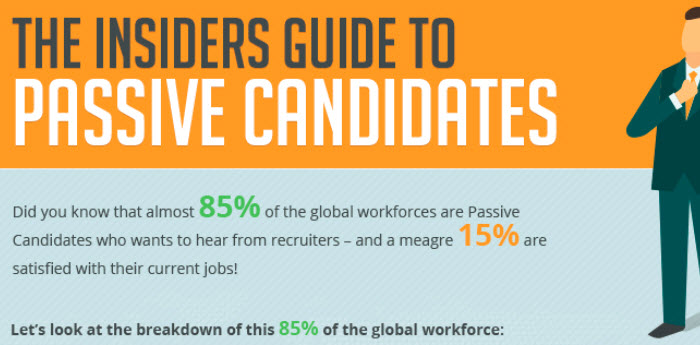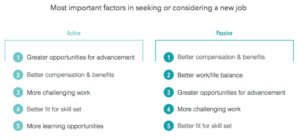
What are the best ways to attract passive candidates?

What are the best ways to attract passive candidates? Hiring a passive candidate for a recruiter is more complicated than an active candidate in the Job search.
Every recruiter knows the best candidates are often already employed. But, it doesn’t mean they are not worth pursuing. Passive candidates or people who are currently working and not actively seeking a new job are an essential element of any comprehensive hiring strategy.
Most often, passive candidates are difficult to recruit than active candidates. So to assist you with your recruiting efforts, we have put together a list of modern tips to recruit passive candidates in 2020.
You may ask why we should spend our energy sourcing people who might not want to switch jobs. Believe it or not, hiring passive candidates isn’t as difficult as it seems. In fact, 85 per cent of employed professionals around the world are open to new opportunities. Plus, if you neglect passive candidates, you’ll miss out on some great candidates. Passive candidates are more likely to make a strong impact on your firm and recruiting them worth the extra effort. Here’s what we recommend for you to consider:

Know the best ways to attract passive candidates

- Invest in AI.
It’s no secret that artificial intelligence (AI) brought a lot of changes in the recruitment industry. Using advanced automation tools to source applicants not only saves your time, but it can also aid you to discover higher-quality candidates.
AI-enabled tools can scour the web and analyse vast quantities of candidate data, and then foretell which passive candidates are ready to accept new opportunities. It would be near-impossible for a recruiter to make this kind of predictive analysis manually. If you haven’t welcome artificial intelligence yet, it’s time to get on board.
- Engage passive candidates on social media.
Social media is the best friend of modern recruiter. Studies show that recruiters who use social media to recruit can see a 50 per cent increase in candidate quality. But using social media is not enough to spot passive candidates. You must also know how to engage with them efficiently.
Here’s what we recommend by platform:
LinkedIn: There are a few hiring managers claim that passive candidate recruitment on LinkedIn has been less effective. Let me tell you that it is because recruiters on LinkedIn are all competing for the same pool of applicants.
But just because there are numerous recruiters on LinkedIn, doesn’t mean you should stop using the platform. Conduct your candidate research as usual. But instead of reaching out within the platform, work with a contact data provider to source contact information of the candidates. Then reach them out using a direct dial phone number or email address. It will cut through the LinkedIn noise and will increase your likelihood of attracting a candidate’s attention.
Facebook: Although Facebook does not typically see as a recruiting platform, it offers some unique search features that let recruiters perform highly targeted candidate searches. Once you’ve identified a high-quality candidate, shoot them a message! It isn’t a tactic that will always work, so use it sparingly. Explain that you don’t usually contact candidates through Facebook, but that you have an excellent opportunity for them. Then the number of positive responses you will get might surprise you.
Twitter: Similar to Facebook, Twitter proffers unique search functionality that employers can use to pinpoint everything from industry-related hashtags to user complaints about their jobs. Just as you would do on Facebook, conduct your outreach within the platform or secure their direct contact information using the help of a B2B contact database.
- Tailor your employer brand to attract passive candidates.
The modern job seekers have access to a wealth of information about your company, and they will use it.
- Studies show that most of the passive candidates perform extensive research on their own before they consider switching jobs.
- Sixty-six per cent of people who changed jobs were aware of the company they joined before applying.
- Ninety-two per cent of candidates would consider jobs changes if a firm with an outstanding reputation offered them a job position.
If you are not aware of what steps to take to improve your brand as an employer, here’s what we recommend:
Emphasize growth: Most professionals give preference to career growth and developmental opportunities in a job. It means that people don’t change their jobs for short-term benefits. They do it when they believe it’s the proper next step in their career ahead. Collaborate with your marketing department and create specific content that pleases passive candidates, prioritising the growth opportunities at your firm.
Showcase company culture: Passive candidates won’t get ready to leave their current role unless they feel confident that they will love working somewhere else. Share photos and videos of your current employees interacting at the organisation, having fun at work events, etc. Present a full scoop of what makes your company an enjoyable place to work.
Encourage employee advocacy: Incentivise your people to share branded content on their personal social media profiles. In today’s socially-driven environment, candidates trust their peers much more than they trust brands. Research shows that most job seekers say they are more likely to apply for a job opportunity if they come across it on the profile of someone they know rather than through the feed of a firm or even a recruiter. When your employees share your content online, it shows passive candidates that your team members are engaged and passionate about their job roles.
Update review sites: Review sites like Glassdoor is an indispensable marketing tool for potential employers. If a passive candidate checks your Glassdoor profile and sees poor reviews, they won’t be interested in working for you. So, ensure your profiles get updated with helpful information, a gallery of pictures, and any open positions.
Similar to other professions, it’s easy for your strategy to grow stale when you do something long and more than enough. But, unfortunately, as the recruiting climate changed and technology continues to advance, the same old tactics are working no longer. New tools and hiring strategies aren’t something to be wary of. Instead, we say, embrace these new strategies and techniques as more efficient and effective ways to find the best candidates.





